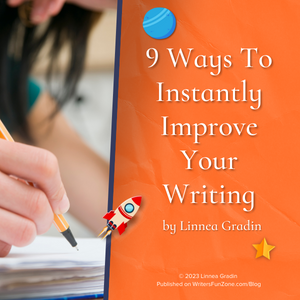9 Ways To Instantly Improve Your Writing by Linnea Gradin
 Let’s welcome back Linnea Gradin as she shares with us “9 Ways To Instantly Improve Your Writing.” Enjoy!
Let’s welcome back Linnea Gradin as she shares with us “9 Ways To Instantly Improve Your Writing.” Enjoy!
***
You may not think of yourself as a writer by trade. But whether you want to start freelance writing as a career, or publish a book, honing your writing skills is essential if you want to get closer to your goal.
It’s said that it takes 10,000 hours to become an expert in any skill and while quick fixes are no substitute for consistent hard work, here are a few easy changes that you can make to instantly transform your writing.
1) Be active
Switching from the passive voice to the active is one way to instantly add impact to your writing — and all it takes is a little word-shuffling.
A lot of sentences read better in the active voice. For example: saying ‘Clark disrupted his industry’ is a whole lot clearer than ‘The industry was disrupted by Clark.’
There are other benefits, too. The active voice:
- Makes your writing more concise and less convoluted;
- Ensures that action and actors are the focus of the sentence;
- Sounds more authoritative and direct.
2) Show your personality
Instinctively, we veer on the side of caution when it comes to sharing personal anecdotes or using a chatty tone in a professional context — but this instinct isn’t always helpful. Instead, showing your personality is key to creating compelling content. The genuine human connection you develop with your audience is what will keep them coming back for more.
For nonfiction especially, don’t be afraid to get personal: be conversational, crack the odd joke, and use the first person (‘I’ and ‘we’). You’ll be surprised how much of a positive difference you can make to your writing by letting the real human peek through.
3) Cut out fluff
Nothing takes the wind out of your writing’s sails like an uncertain tone. Ideally, your authorial voice should sound self-assured, and one way to do that is to remove unnecessary fluff and filler.
In other words: make your writing convincing, by sounding convinced. Here are a few easy stylistic quick fixes:
- Cut out qualifiers: ‘This technique has been pretty revolutionary’ packs less of a punch than ‘this is a revolutionary technique.’
- Remove ‘that’ where possible: ‘I believe that this man is a genius’ can be streamlined down to ‘I believe this man is a genius.’ You may also consider whether it would be more assertive without the first verb: ‘This man is a genius’.
- Be sparing with adverbs: unless they add information you wouldn’t receive otherwise, your adverbs will quickly make your writing clunkier.
4) Mind your beginnings and endings
This tip works for both the entire piece and its constituent parts.
An introduction and conclusion are important for obvious reasons: they provide our hook and our payoff. But the beginning and ending of each paragraph are also vital, because they inform us of the topic and provide a logical link to the next section, respectively.
This also applies on the sentence-level. In particular, is there enough variation in how you start and end sentences? Avoiding a string of sentences starting with “and” or “then” is a quick way to tighten up your writing.
5) Experiment with layout
The way you format your writing on the page can be visually striking — and more impactful than you might at first think. Instead of providing readers with an indigestible block of text, help your readers parse out the important parts by, for instance:
- Breaking up paragraphs with line breaks,
- Bolding key points, or
- Using bullet points to make your content more scannable.
The takeaway: experiment! The blank page is your canvas, and you’re the artist; play around with the placement of text on the page to give your words maximum impact.
6) Show, don’t tell
It’s the classic tip given to all writers: almost any type of writing can be improved by showing, not telling.
Take a blog post about writing techniques. What would be more convincing: a post that simply tells you that active voice often results in shorter sentences, or one that shows you the results side by side? Probably the latter. Showing engages readers, invites them to make their own deductions, and demonstrates the case you’re making; while telling asks readers to believe you only on the basis of your flat exposition.
To make sure that you’re showing, you can perform a few simple checks:
- Comb your writing for any important claims you’re making. Are they backed up by evidence in the form of case studies, data, and statistics?
- Are there any opportunities to include images or other graphics?
- Are there any opportunities to strengthen your writing by offering examples to support a statement, or a mini-story to better engage the reader?
7) Change up sentence length
Repetitive sentence length bores readers. Sentences become monotonous and blend together. Every idea is given the same level of priority. It’s hard to tell what’s most important.
Do you see what I mean?
A block of text made up of a string of samey sentences gets pretty tiresome, pretty quickly, while a paragraph where sentence length varies is instantly more dynamic — and therefore more impactful!
Try to change up sentence structure and length frequently. Using longer sentences can be helpful when you’re trying to expand on an idea, but too many long sentences in a row can make a paragraph hard to digest. Meanwhile, short sentences can be punchy when you’re expressing a key idea. Just be sure to use them sparingly, or they’ll lose their sting!
8) Re-read your work
This is probably the easiest tip on the list, but re-reading your own work can make a huge difference to the quality of your writing.
Good writing can be read aloud with minimal effort, and there’s only one way to find out if your writing is up to the challenge — giving it a go.
Read what you’ve written aloud, and pay attention to any words you stumble over, or sentences that don’t sound right. This technique helps you find natural sentence breaks, and can be the quickest way to spot grammatical errors. If it doesn’t sound right coming out of your mouth, it’s not right on the page!
9) Just write
I hinted at this at the start of the post, but it bears repeating: there’s one sure-fire way to improve your writing — and that’s writing.
At the end of the day, done is always better than perfect. Sometimes the only way to learn is to bump up against obstacles and overcome them in the writing process. And the fact is that the first step on your thousand-step-journey is enough for you to start improving.
Even if the progress is gradual, you are guaranteed to be instantly better at writing — simply for having written.
***
ABOUT THE AUTHOR
![]() Linnea Gradin writes about writing and publishing over at Reedsy — a website that connects authors with publishing professionals and gives tips on topics such as how to self publish a book or how to translate a book.
Linnea Gradin writes about writing and publishing over at Reedsy — a website that connects authors with publishing professionals and gives tips on topics such as how to self publish a book or how to translate a book.






